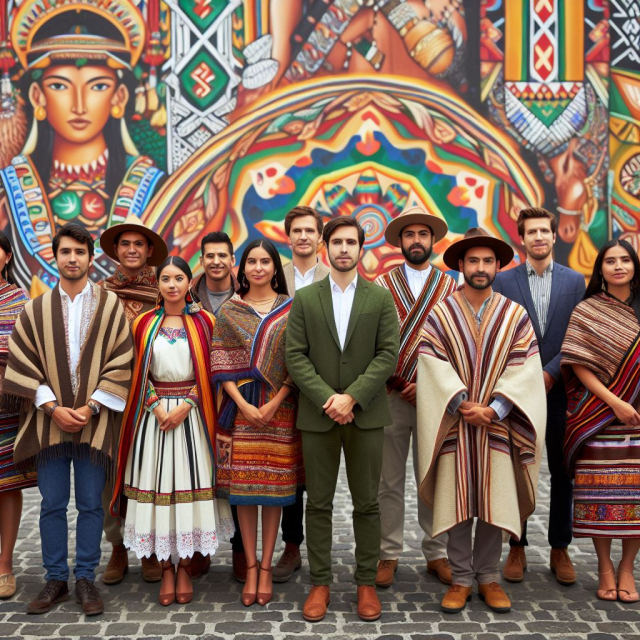Ecuador, a country located in the northwest region of South America, is recognized for its geographic, cultural and ethnic diversity. This nation, with its astonishing variety of landscapes ranging from the Amazon rainforest to the snow-capped peaks of the Andes, is also home to an equally diverse population, which has evolved over millennia of migrations, cultural exchanges and historical processes. To understand the origins of the Ecuadorian population, it is necessary to immerse yourself in a fascinating journey through time and explore the multiple influences that have shaped its demographic and cultural composition.
The first settlers:
The first vestiges of human presence in what is now Ecuador date back to more than 14,000 years ago, according to archaeological evidence found in sites such as Las Vegas, Santa Elena and Loma Alta. These first inhabitants were hunters and gatherers who migrated from northern South America, following the course of the rivers and adapting to the diverse ecosystems of the region.
One of the most important finds that sheds light on these early settlers is the Valdivia culture, which flourished between 4400 and 1500 BC on the Ecuadorian coast. Valdivia ceramics are especially recognized for their beauty and sophistication, and represent one of the oldest artistic expressions in America. This culture, along with others such as the Machalilla and the Chorrera, laid the foundations of agriculture in the region, growing corn, beans, pumpkins and other crops.
The pre-Columbian era:
The region we know today as Ecuador was inhabited by a number of advanced indigenous cultures before the arrival of the Spanish in the 16th century. Among these, the Caras stand out in the mountains, the Quitus in the Quito region, the Cañaris in the south, the Huancavilcas on the coast, and the Incas, who conquered a large part of Ecuadorian territory at the end of the 15th century.
The Inca influence was especially significant in Ecuador, since they established important administrative and cultural centers in the region, such as Tomebamba (present-day Cuenca) and Tumebamba (present-day Ambato). The integration of the Ecuadorian territories into the Inca Empire allowed the spread of the Quechua language, which continues to be spoken by many indigenous communities today.
The conquest and the colony:
The meeting between the indigenous world and the European world occurred in 1526, when Francisco Pizarro explored the Ecuadorian coasts. However, the Spanish conquest was not consolidated until 1534, with the founding of the city of Quito by Sebastián de Benalcázar. From then on, Ecuador became part of the Viceroyalty of Peru, as another Spanish colony.
During the colonial era, the Ecuadorian population experienced a profound demographic and cultural transformation. The arrival of the Spanish brought with it the introduction of new diseases, such as smallpox and measles, which decimated the indigenous population. In addition, a system of encomiendas and haciendas was established that exacerbated the exploitation of the natives and the concentration of land in the hands of a few.
However, the colony was also a period of miscegenation and cultural syncretism, where European traditions mixed with indigenous ones, giving rise to a new mestizo identity. The colonial architecture, with its churches and stately mansions, is a tangible reflection of this fusion of cultures.
Independence and the construction of the national state:
Ecuador's independence process was marked by class struggle and tensions between the different regions of the country. In 1809, the first independence uprisings occurred in Quito and Guayaquil, although they were not successful at that time. Finally, on May 24, 1822, in the Battle of Pichincha, the independence forces led by General Sucre defeated the royalist troops, ensuring the independence of Quito.
However, the construction of the Ecuadorian national State was a long and complex process. During the 19th century, the country experienced numerous civil wars and territorial conflicts with its neighbors, which made it difficult to consolidate a centralized and democratic government. Furthermore, the abolition of slavery in 1851 and the Liberal Reform of 1895 contributed to reconfiguring the social and ethnic structure of Ecuador.
Cultural and ethnic diversity:
Today, Ecuador is a multicultural and multiethnic country, where diverse identities and worldviews coexist. The 2008 Constitution recognizes plurinationality and interculturality as fundamental principles of the Ecuadorian State, guaranteeing the rights of indigenous and Afro-descendant peoples.
The Ecuadorian population is mainly made up of mestizos, descendants of the mixture between indigenous people and Europeans, who represent around 71% of the population. Indigenous peoples, such as the Quichuas, Shuar, and Huaoranis, make up about 7% of the population, while Afro-descendants, descendants of African slaves, make up about 7% as well. In addition, there are communities of European, Asian and Arab origin that have contributed to the ethnic and cultural diversity of the country.
The origins of the Ecuadorian population are as diverse and complex as its geography and history. From the first settlers who arrived thousands of years ago, to the fusion of cultures during the colonial period and the construction of the national State in the 19th century, the Ecuadorian population has been shaped by a multiplicity of influences and historical processes.
Today, Ecuador faces important challenges in terms of economic development, social inclusion and environmental protection. However, its cultural and ethnic wealth constitutes an invaluable asset that must be valued and preserved. Recognizing and celebrating the diversity of the Ecuadorian population is essential to building a more just, equitable and pluralistic country in the 21st century.
